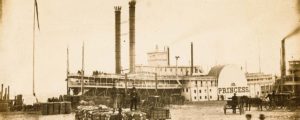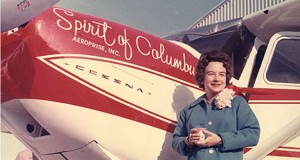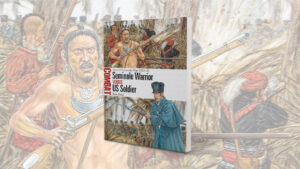Soldiers with M-16s welcomed Air Force Captain Eunice Splawn to the airfield outside the 22nd Casualty Staging Facility in Da Nang. She had volunteered to work in the one place in the world that needed her most, Vietnam. The date was January 16, 1968.
Splawn and seven other nurses, the first women to serve at the 22nd, entered a guarded compound and surveyed their makeshift hospital. Engineers had welded four modular trailers together to create the large staging facility. The new arrivals quickly blended their skills with medical staff, corpsmen and technicians to care for seriously wounded American, South Korean, Australian and South Vietnamese soldiers.
Fifteen days after the nurses’arrival, the January 1968 Tet Offensive struck throughout Vietnam. The increased fighting in Da Nang threw the staging facility into a more hazardous war zone. With the siege of Hue, the “Mini-Tet offensive” in May and several enemy campaigns, Captain Splawn and her staff dug in and treated a steady stream of casualties for the next five months.
Each wounded soldier had to be treated and stabilized for flight within 12 hours of arrival. The staff worked at a fast pace, always aware that the enemy used the protection of darkness to move artillery in and to strike at will. Splawn recalls: “We had to get our patients in and out during the daylight hours. If the patients arrived later in the day, we didn’t have time to get them on their way. Many nights we had to dive underneath the beds with the patients to avoid…rocket fire.”
Splawn herself contracted severe bronchitis that landed her in a hospital bed. The head nurse went from caring for as many as 70 wounded soldiers at one time to enduring doctor-ordered bed rest. Soon, however, she felt compelled to return to nursing soldiers half-days.
From an early age, Eunice had wanted to be a nurse. During nursing school in her hometown of Spartanburg, S.C.; hospital work in Michigan and Florida; and college years at Bob Jones University in Greenville, S.C., she longed for travel and adventure. In 1961 she joined the Air Force.
Before volunteering for Vietnam, Eunice served in Wiesbaden, Germany, where she reached the rank of captain. She also served at Patrick Air Force Base in Florida, and received training for in-flight patient care at Brooks AFB in Texas. This travel, along with her maturity, elevated Eunice to the role of big sister in the Da Nang staging facility. Other nurses and corpsmen, suffering from homesickness or trauma from the difficult work, sought her guidance and comfort. “They would come to me,” she remembers, “though I wasn’t that much older….All they wanted was someone to say: ‘I care. Let’s just keep going.’”
Normally, wounded soldiers treated the women nurses with respect, but many men who worked in the compound did not always behave like gentlemen. “We had a lot of harassment issues,” says Splawn. “Verbal harassment was awful. We were targets for guys who came in from other places. Healthy men wandered through our quarters, looking for a girl. Often I had to say, ‘Hey, we’re not over here to be a dolly; we’re over here to take care of patients.’” Pilots from the Jolly Greens, the Sikorsky HH-3E search-and-rescue helicopters, took Eunice and her friend Sandra Young under their wing. No one bothered them when the pilots were around. The staging facility corpsmen were also protective because they needed the nurses to get through the work.
Eunice witnessed horrific sights and sounds that have lingered in her memories. On one occasion a 17-year-old soldier, who had lost both eyes in an attack, lay in the ward with his fingers wrapped around a Purple Heart. Splawn knew that many considered it a great honor to receive a Purple Heart, but she remembers thinking, “What can ever take the place of those eyes?”
The medical staff often treated battlefield amputations, napalm burns, and shell fragment and gunshot wounds. Splawn explains an innovative procedure: “For the first time in wartime treatment facilities, wounds were not closed. They called it open wound treatment. Field hospitals would close the wound so nothing was hanging out but left it open so the antibiotic creams and powders could be applied easily. Because of this treatment, we did not have internal necrosis, or dying tissue. We did not see gangrene….We did, however, see maggots, because they would appear within one day in a soldier who had lain in a rice paddy or contaminated water.”
Whenever possible, Captain Splawn flew with a doctor and a Vietnamese corpsman on MEDCAP (Medical Civil Assistance Program) helicopters that brought first aid and health care to South Vietnamese towns and villages. These missions served as gestures of goodwill but were very dangerous. The Vietnamese pilots flew at treetop level. “We occasionally took small arms fire because we didn’t use big airports with security.”
Although village elders tried to secure the landing areas, they were not safe. Villages were not safe either. Splawn recalls that the Viet Cong often used children to do their dirty work. Children were known to approach with a smile, then toss a Molotov cocktail.
Another hazard that ranked high on MEDCAP missions was contagion. To guard against malaria, hepatitis and parasitic infections, the medical staff took preventive medications and avoided all contact with contaminated water and drainage ditches.
Captain Splawn and MEDCAP staff members administered medication to adults and immunizations to children. “I often wondered if we were doing any good…because you saw patients with heart problems receive medication, and then you’d see them swap pills with each other.”
MEDCAP staff also treated dental problems, scabies and infections. For infections, the staff had to distribute unwrapped soap bars to villagers. They knew wrapped soap brought good money on the black market.
On MEDCAP missions, Splawn viewed firsthand some disturbing aspects of the jungle war. “No lines separated the enemy. You didn’t know…if you were meeting a North Vietnamese or a South Vietnamese, a Viet Cong or a Vietnamese National. We know we treated Viet Cong [but] they weren’t going to tip their hand to us.”
Children loved the MEDCAP missions: “They climbed all over us because we were different.” Splawn had great empathy for orphaned children growing up in a combat zone. “Some of the staff went to the orphanages during their time off and played with the children. With a captain’s responsibilities, I never had time to do that.”
Responsibilities kept her tied to a hectic schedule until she concluded the Vietnam duty tour in January 1969. “It was one of the most rewarding years, as far as work is concerned, that I’ve ever spent. We knew we were needed.”
Twenty months later, she volunteered to return. By September 1970 the war in Vietnam had long been unpopular at home, but Captain Splawn focused on the work to be done. Without skilled nurses, wounded American soldiers would die. Changes in the political climate had not changed that reality.
For her second tour, Splawn worked as a flight nurse with the 57th Air Evacuation Squadron out of Clark AFB in the Philippines. She flew several different routes from Clark. Huge C-141s flew daily flights into each of the staging facilities at Da Nang, Cam Ranh Bay and Tan Son Nhut Air Base. The medical staff included two nurses and three corpsmen.
On Captain Splawn’s first flight with the air evac, the plane flew into Da Nang. Painful memories flooded in, making her realize how much she had chosen to forget. She says she pulled a familiar hard shell around herself so flashbacks and disturbing new experiences would not bother her. Splawn credits her family’s strong military background and their loving support—as well as her faith—for the strength it took to keep that shell intact through the months ahead. “It was extremely tough….I felt this way: If God will take care of me anywhere, He will take care of me here, too.”
In the spring of 1971, drug patients filled many of the air evac flights leaving Vietnam. The crews called them “golden flow” flights. “When they got to Vietnam, a lot of young men who had used marijuana in the States took advantage of the widespread availability of the highly addictive drug heroin. The policy stated that urine samples had to be clear before they could be taken out of Vietnam on planes.” Addicted soldiers had to wait at the 6th Army Base Hospital in Cam Ranh Bay until an early-morning urine sample tested negative. “Some of them were in a state of agitation, but they were not medicated. We kept medication for them locked up in case we needed it, but we relied on armed marshals to keep things under control.” Many of these men acted like children, and flight nurses had to perform baby-sitter-type duties. The nurses represented mothers, sisters or girlfriends—those loved ones back home—and felt overwhelming compassion for the soldiers on these flights.
Splawn received a three-month tour extension (to 18 months) and a promotion. In March 1971, Major Splawn completed her second duty tour in Southeast Asia and returned to Shaw AFB in South Carolina. There she trained and then worked as a primary care nurse practitioner. Her duties included diagnosis and treatment of military personnel, dependents and retirees.
From conversations with many patients, she learned that unsuccessful drug rehabilitation was not the only reason thousands of veterans suffered from their participation in the Vietnam War: “Those men who stayed in the military…did not have the trouble that those who left the military setting did. In the military you always had someone to talk to about the war. If a soldier came home and left the service, no one wanted to hear about Vietnam. There’s nothing much worse than that, when you’re troubled about taking a life or losing a friend.”
Eunice Splawn had attained the rank of full colonel by the time she retired from the Air Force Reserves in 1981.
Originally published in the February 2007 issue of Vietnam Magazine. To subscribe, click here.




